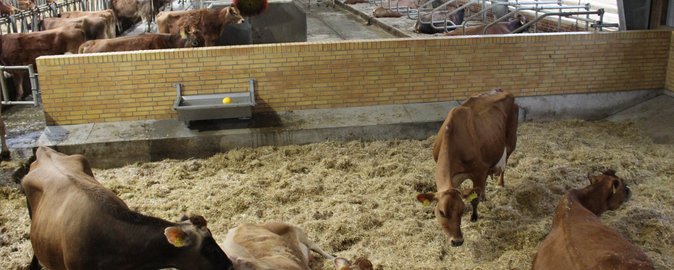



Lame cows recover better when housed in hospital pens
Lame cows benefit from housing in hospital pens. This is – in short - the result from a study made in collaboration between Department of Animal Science, Aarhus University, and SEGES.

Lameness in dairy cows is a major problem in dairy herds worldwide and is associated with reduced animal welfare. It may be difficult for lame cows to compete with other cows in the herd for access to feed, water and lying places. “Therefore, it is reasonable to expect that lame cows may benefit from housing in a hospital pen. Here, the flooring is typically softer, and there are fewer cows and less competition for resources”, says senior scientist Peter Thomsen, who has been involved in the project.
Together with SEGES, the AU researchers decided to study the effect of housing lame cows in hospital pens. During the project, they studied whether lame cows housed in deep-bedded hospital pens recovered better than dairy cows kept together with the rest of the lactating cows in the “standard” barn.
Study in commercial dairy herds
The study included 168 lame dairy cows from five different herds. Each herd was visited once weekly, and lame cows (with a locomotion score of 3 or 4 on a scale from 1 to 5) were examined in a hoof-trimming chute, hoof trimmed when needed, and randomly allocated to one of two treatments:
- Treatment group: housing in hospital pen
- Control group: standard housing together with the other lactating cows in the herd.
Weekly locomotion scoring
Cows were locomotion scored every week until they were no longer lame or until they had been included in the study for three weeks. Based on these locomotion scores, the cows were grouped as follows in order to describe the development of lameness over time:
- Cows recovering from lameness
- Cows with improved locomotion score but without complete recovery
- Cows with unchanged locomotion score
- Cows with worsened locomotion score.
Positive effect of hospital pens
Overall, the results showed a significant difference between the two groups: housing in hospital pens had a positive effect on recovery from lameness.
Among cows receiving a locomotion score 4 at the beginning of the study, 73% of the control cows still had a locomotion score 4 three weeks later. For cows in hospital pens, the corresponding proportion was only 40%. Forty-six percent of the cows in hospital pens had experienced an improvement of their locomotion score compared to only 16% in the control group. Finally, 14% of the cows in hospital pens and 11% of the control cows had recovered completely from lameness during the study period.
“Our results show that lame dairy cows benefit from a stay in a hospital pen. Typically, farmers only house severely lame cows in hospital pens. However, our results indicate that less severely lame cows may also benefit from a stay in a hospital pen”, says Peter Thomsen who also stresses that “this kind of research is only possible thanks to farmers helping us generate interesting research results”.


